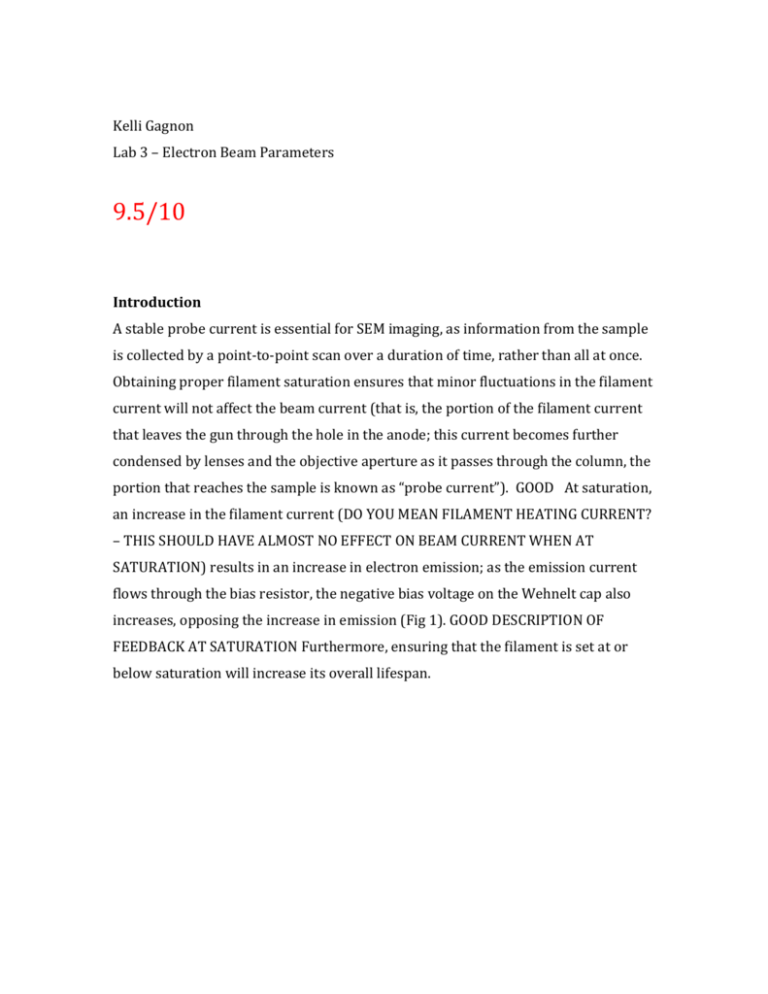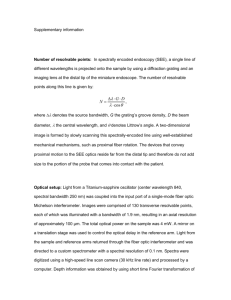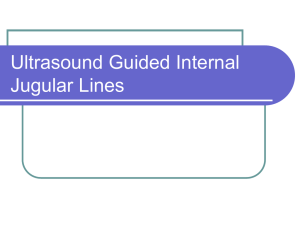lab report - Marshall University
advertisement

Kelli Gagnon Lab 3 – Electron Beam Parameters 9.5/10 Introduction A stable probe current is essential for SEM imaging, as information from the sample is collected by a point-to-point scan over a duration of time, rather than all at once. Obtaining proper filament saturation ensures that minor fluctuations in the filament current will not affect the beam current (that is, the portion of the filament current that leaves the gun through the hole in the anode; this current becomes further condensed by lenses and the objective aperture as it passes through the column, the portion that reaches the sample is known as “probe current”). GOOD At saturation, an increase in the filament current (DO YOU MEAN FILAMENT HEATING CURRENT? – THIS SHOULD HAVE ALMOST NO EFFECT ON BEAM CURRENT WHEN AT SATURATION) results in an increase in electron emission; as the emission current flows through the bias resistor, the negative bias voltage on the Wehnelt cap also increases, opposing the increase in emission (Fig 1). GOOD DESCRIPTION OF FEEDBACK AT SATURATION Furthermore, ensuring that the filament is set at or below saturation will increase its overall lifespan. Figure 1. Cross section of electron gun showing bias resister and Wehnelt cap I THINK YOU SHOULD SPECIFICALLY REFERENCE THESE IMAGES USED IN FIGURES UNLESS YOU MAKE THEM YOURSELF (MAYBE YOU DID MAKE THE FARADAY CUP IMAGE?) The objective of this lab was to observe how the strength of the probe current changes as the filament is being saturated and as different lens settings are applied to the SEM. We used a Faraday cup (Fig 2) to trap the electrons released by the beam and obtained accurate probe current measurements with a pico-ammeter. By obtaining an accurate probe current value, we could then observe how it fluctuates when emission current and various lens settings were changed. The probe diameter was calculated at two different probe currents by scanning a silicon wafer with an electron-opaque edge. The convergence angle of the beam was calculated by measuring the beam at two different working distances; based on these values we also estimated functional aperture. Using a drill bit, we discerned the depth of field from two images and observed the effect of working distance on depth of field. Figure 2.Cross-section of a Faraday cup measuring probe current. Probe current enters the cup through the aperture, all electrons are absorbed and measured by the picoammeter. Methods A mounted silicon chip and Faraday cup were placed in the sample chamber; a wire from the Faraday cup was connected to the pico-ammeter via a port inside the chamber. The chamber was evacuated and the filament was turned on and warmed up using the knob below the HT button. The filament was set to just below saturation. To achieve max saturation the current had to be aligned over the anode hole in the Wenhelt cap. The emission current increased as the filament was heated and was 83uA at the point of saturation (found on the L.C. readout of the panel). To find the probe current, the aperture of the Faraday cup (Figure3) was located and centered on screen. To direct the current into the hole, the hole was zoomed in until it completely engulfed the screen (alternately, a spot beam could be directed into the hole). Figure 3. Aperture of the faraday cup imaged at 350x. The spot size was adjusted to achieve probe currents of 10nA and 0.1nA; the Condenser settings and Emission currents were recorded (Table 1, Results). The spot size was then adjusted to 8, 12 and 18; the objective lens was kept constant and the probe currents for each spot size were recorded (Table 2, Results). Finally, the probe diameter was measured by observing the rise/fall in signal (Figure 4) as the beam was swept over the sharp edge of the silicon chip (Figure 5). THIS METHOD WOULD NOT BE CLEAR TO SOMEONE NEW TO THE LAB – IT IS TRICKY BUT MAY INVOLVE ONE MORE FIGURE SHOWING THE BEAM SWEEP ACROSS THE EDGE OR JUST A BIT MORE TEXT this was done using probe currents of 0.1nA and 1.0nA and recorded along with condenser settings (TABLE 4). Figure 4. Silicon wafer edge, which was used to measure probe diameter. Figure 5. Method of measuring probe diameter from a tracing of a signal waveform (MORE LIKE A SIGNAL INTENSITY VS DISTANCE PLOT) at spot sizes 8 and 12, diameter was measured and corrected for 50,000x magnification at each setting. The beam convergence angle (Figure 6) was calculated by measuring the diameter of the beam at two different working distances (the difference between them defined as DELTA “z”) with focus held constant to obtain “di” and “df” (initial and final beam diameters). With these values, the convergence angle (a) was determined using the following equation: tana=(1/2 df-di)/z. With this angle, the functional aperture was able to be estimated as well (FIGURE 8 AND TABLE 5). Figure 6.Schematic diagram of the depth-of-field in an SEM image, showing location of convergence angle and how depth-of-field may be calculated. Depth of field was observed using a drill bit flute. Using the equation D=0.2mm/Mag*a, depth of field was calculated at magnifications 50x and 5000x. Depth of field was also experimentally measured from an image of the drill bit by measuring the amount of the image that appeared in focus in ImageJ. Results Objective Aperture Condenser setting Probe current Emission current (spot size/I.C.L.) (L.C.) 50 um, virtual pos. 18/ 95mA 10 nA 83 uA 50 um, virtual pos. 8/ 168mA 0.1 nA 83 uA Table 1. Effect of condenser settings on probe current and emission current. Changing the spot size affected the probe current (probe current increased with spot size), but the emission current remained unchanged. This is as to be expected, as the condenser lens is located below the anode where emission current is measured. The probe current is much smaller than the emission current, as the anodes are taking up much of the electrons The objective aperture is also holding back electrons as the aperture is smaller than the beam; these electronstravel through the metal sides of the column to ground. Spot size Condenser lens current Probe Current 8 168 mA 0.1 nA 12 117 mA 1.0 nA 18 95 mA 10 nA Table 2. Effects of condenser lens settings on probe current; objective lens held constant at 400 mA. wd (estimated) Objective lens current Probe current 25 mm 435 mA 0.8 nA 30 mm 406 mA 1.1 nA 35 mm 390 mA 1.1 nA Table 3. Effects of objective lens current on probe current, condenser lens held constant at 117 mA. The condenser lens current is adjusted by lowering or raising spot size; the affects the probe current by cropping the beam as the spot size decreases. This can be seen in that the probe current increased by a magnitude of 10 as the spot size is increased by a value of 6. The objective lens current is controlled by focus or working distance; as the beam has already passed through the condenser lenses, changing the objective lens current will not affect it as much. These results were plotted in Figure 7. Figure 7. Objective lens and condenser lens effect on probe current. Objective lens is in red, condenser lens is in blue. Note that the condenser lens has a much greater effect on probe current than objective lens. GREAT PLOT Probe diameter was measured using the procedure in Fig. 5 while the spot size was adjusted and all other parameters were held constant. It was observed that probe diameter increases with increasing spot size (Table 4); this is important as an image obtained with a smaller probe diameter will have a better resolution with more fine detail. Aperture Probe Current Probe Diameter 50 um, virtual pos. Condenser Setting (spot size/I.C.L.) 8 / 168 mA 0.1 nA 20 nm 50 um, virtual pos. 12/ 117 mA 1.0 nA 40 nm Table 4. Effects of condenser settings on probe diameter. Convergence angle and the functional aperture were calculated using the method illustrated in Figure 8. Probe diameter values (di, df and Δ d) were calculated using the method shown in Figure 5. The values for these calculations are listed in Table 5. Figure 8. Calculations for beam convergence angle and estimating functional aperture using the values obtained in Table 5. NICE DIAGRAM di (nm) df (nm) Δ d (nm) zi (mm) zf (mm) Δ z (mm) a (rad) fa (um) 80 1160 1080 14 13.5 .5 0.001 30.24 Table 5: Measured and calculated values for beam convergence, using a spot size of 12 with the aperture held constant and in the 50um virtual position. Depth of field was calculated at working distances of 11 mm and 31 mm, and at magnifications of 50x and 5000x using the formula D=0.2mm/Ma. The 0.2 mm factor accounts for the limitations on the human eye when viewing an SEM screen. It was observed that depth of field is greater with larger working distances when the convergence angle is narrower, which is expected. These values are listed in Table 6. Finally, images of the drill bit flute at wd 11 mm and 30 mm were captured at 50x and the depth-of-field was experimentally measured in ImageJ (Figure 9). Figure 10 illustrates how these measurements represent the depth of field for the image. wd Convergence D at 50x D at 5000x 11 mm 0.0028 rad 1.429 mm 0.014 mm 31 mm 0.00098 rad 4.082 mm 0.041 mm Table 6.The effect of working distance on depth of field.Aperture diameter 50um, functional aperture diameter 30.24 um. The greater working distance for 50x has a depth of field 2.8 times larger than the smaller wd. Figure 9. Depth of field measured experimentally in ImageJ. Left is working distance 11, right is wd 31. The greater working distance has a depth of field 2.3 times larger Than the smaller wd. IT ISNT CLEAR THAT THE WD SHOWN HERE ARE NOT THE ACTUALLY MEASUREMENTS FOR DEPHT OF FIELD – I DO THINK THAT YOU UNDERSTAND Figure 10.Illustration of drill bit flute showing depth of field at 11mm and 31mm working distance. References 1) Goldstein, J.; Newbury, D.; Joy, D.; Lyman, C.; Echlin, P.; Lifshin, E.; Sawyer, L.; Michael, J., Scanning Electron Microscopy and X-Ray Microanalysis. 3 ed.; Kluwer Academic/Plenum Publishers: New York, 2003. 2) Lyman, C.E.; Goldstein, J. et al., Scanning electron microscopy, X-ray microanalysis, and analytical electron microscopy: a laboratory workbook. Plenum Press: New York, 1990. 3) Neff, D and Norton, M. SEM Laboratory 2: Beam Parameters. Marshall University, 2010. 4) http://www.marshall.edu/mbic/instrumentation/SEM/sem.html 5) http://www.science.marshall.edu/dneff/course2013/semLAB2/drilldepth_2013.pptx YOU FORGOT THESE QUESTIONS BUT I THINK YOU GOT MOST OF THE BIG IDEAS How does the beam current at the specimen compare with the emission current at the gun? Where did the rest go? Note that the emission current did not change for the high-beam-current setting because no change was made to the gun parameters. Name three ways to change the emission current. Why would you want to change the emission current? Can saturation be determined by measuring the secondary electron signal with the E-T detector instead? The emission current (readout L.C. on panel)? Compare the ratio of probe diameters to the ratio of probe currents (low/high) to the ratio of probe diameters (low/high) for the two operating conditions Why is there such a difference in the influence of these two lenses on the probe current?





![[sample] Focus Group & Individual Interview Guide](http://s3.studylib.net/store/data/006626260_1-52ac55bdb30beaa664c3c37fc5ba0cb1-300x300.png)

